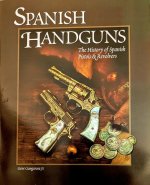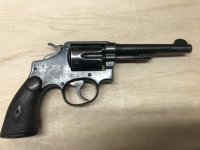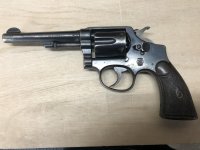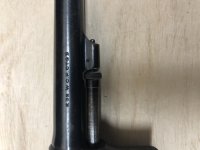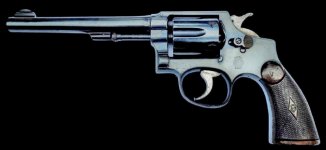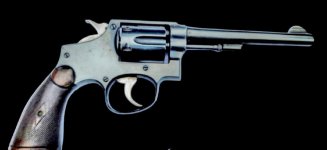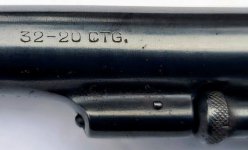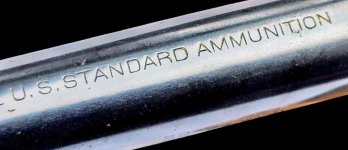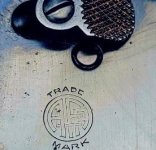I am an author and historian doing research on a book that I am writing about a double murder that occurred in my home town in Tennessee in 1943. I know this is probably a long shot and I will apologize for the long post in advance, but I'm needing some information and clarification on the murder weapon that was used in this case. It was described in the F.B.I. report as an "inexpensive, blue steel, .32-20 Spanish revolver, Serial #10367. I was told by someone that it could possibly be a post WW1 Eibar S&W clone. But this is just a SWAG based on the available info. Unfortunately I do not have a photograph of it. I sure wish I did! It would make this SO much easier. Any thoughts?
Anyway, for a bit of background, when this weapon was finally turned over to law enforcement, evidence showed that the cylinder was fully loaded with 4 rounds of .32-20 WESTERN which were live rounds, and two empty shell casings of .32 WCF REM-UMC ammunition. This was due to the fact that the weapon had been shot twice at the murder scene, one round to the head for each victim.
To make an already long story a little shorter, the .32-20 belonged to a deputy sheriff of 35 years who claimed that it had been "stolen" from his home about 7 weeks prior to the murders. One of the victims was his wife's 21 year old niece and the other was the niece's 27 year old husband (who the deputy, by the way, hated). A handwritten statement about the murders, from an unsigned source was recently found tucked away in box in the attic of what was then the district attorney general's office and who was also the prosecutor of this case. Comparing multiple documents and records, the "Mystery Statement" as I call it, was clearly written by the DA but the subject giving the statement is unknown. The content of it however indicates that the deputy in question had hired the one giving the statement to kill his niece and her husband and had not only given this individual his .32-20 to use but had taken part in the crime itself. Incidentally, this mystery statement (along with some other highly questionable information) never made its way into court.
The victims were at the deputy's home when this happened. The deputy and his wife had gone away for the day and had left the couple there alone. After the murders, the .32-20 was left at the scene, stuck barrel up, between the right arm and body of the deputy's niece. Neighbors found the couple and sent word of what had happened. When the deputy and his wife returned, he immediately walked into his house, into the room where the bodies were, walked directly to the body of his niece and says he immediately recognized (what he could see of) the weapon as the one that was "stolen". He then quickly picked it up, took it outside, unloaded it, reloaded it, took it back into the house, wrapped it up in a rag and stuck it in a dresser drawer. Although there was a witness that testified that he saw the deputy bring the weapon outside and unload it, the deputy stated he did not open the cylinder nor did he unload it but did notice there were two empties in the cylinder. This was no doubt a lie. He did actually admit to doing everything else. His reasoning behind the actions was he "was bothered" and "didn't know what he was doing". Several really shady events followed.
In the end, two men, one I am 99% sure was innocent, were prosecuted, convicted and ultimately executed in the electric chair less than a year later. That was the end of this story until about a year ago when I started down this really deep rabbit hole. That's when all of this new evidence was accidentally found that had been tucked away for eighty years in a dusty old attic. Now, I'm wanting to tell "the rest of the story".
Needless to say, this weapon holds lots of questions that I am desperately trying to answer in order to document this case as accurately as possible in my book. So my thoughts were, what a better place to ask, is in a forum of people who may hold some of the answers I need. Here are some of the questions I'm trying to answer ...
1. Were the .32-20 WESTERN and .32 WCF REM-UMC ammunitions interchangeable in the .32-20 revolver? I understand that one of them was possibly a rifle cartridge? I do have photos of the ammo that supposedly came out of the revolver if that helps.
2. Does anyone else find it odd that the only two empty cartridges were of the same ammo? As mentioned earlier, some really shady stuff went on and the weapon had a questionable chain of custody after the crime. It might also be important to mention that it was said that a second, shooter could have been involved who was using a .32 caliber revolver, the same caliber as the empty casings. However, this information only appeared in the "mystery statement" that was later found.
3. If the weapon is indeed an Eibar Spanish S&W clone, does anyone know of any source for finding the ID of the weapon using the serial number? I have not been able to find a source anywhere that gives any information on that serial number. I would really love to ID it and possibly find a photo of the same model of weapon.
4. Does anyone know if the cylinder on these weapons rotated clockwise or counter clockwise and if they were primarily single or double action?
5. The soft lead bullet that was removed from one of the victims weighed .99 grains but according to the F.B.I. report, it was mangled to the point to where ballistic matching to the weapon (which they also stated had a barrel in poor condition) was not possible. Taking into account the loss of material from passing through flesh and bone (shot in the back of the head with no exit wound) would this weight be consistent with either of the ammunitions that were said to be loaded into the .32-20 at the time? Would the bullet weights for the .32 and .32-20 be about the same?
6. The F.B.I. report stated that the empty shell casings that was sent to them for analysis were "Two .32-20 cartridge cases removed from revolver". It is important to know that the submission letter stated that the weapon was being sent, "loaded and with two empty shells in the same condition as it was found". However, according to the physical evidence that we have on hand, the two empties are clearly stamped .32 WCF REM-UMC. The sheriff, on the witness stand also states that the empties were .32-20. So ... did someone switch them and send different casings to the F.B.I. or is the nomenclature the same? I'm confused with that one.
Again, ANY information you guys could give me would be greatly appreciated. It's really difficult to find information on an almost 100 year old weapon and when the information I do have has been screwed around with, it makes it a great deal harder. I am a female and although I was brought up a country gal, shooting weapons at a young age, this information is WAY above my level of knowledge. Thanks in advance.
Anyway, for a bit of background, when this weapon was finally turned over to law enforcement, evidence showed that the cylinder was fully loaded with 4 rounds of .32-20 WESTERN which were live rounds, and two empty shell casings of .32 WCF REM-UMC ammunition. This was due to the fact that the weapon had been shot twice at the murder scene, one round to the head for each victim.
To make an already long story a little shorter, the .32-20 belonged to a deputy sheriff of 35 years who claimed that it had been "stolen" from his home about 7 weeks prior to the murders. One of the victims was his wife's 21 year old niece and the other was the niece's 27 year old husband (who the deputy, by the way, hated). A handwritten statement about the murders, from an unsigned source was recently found tucked away in box in the attic of what was then the district attorney general's office and who was also the prosecutor of this case. Comparing multiple documents and records, the "Mystery Statement" as I call it, was clearly written by the DA but the subject giving the statement is unknown. The content of it however indicates that the deputy in question had hired the one giving the statement to kill his niece and her husband and had not only given this individual his .32-20 to use but had taken part in the crime itself. Incidentally, this mystery statement (along with some other highly questionable information) never made its way into court.
The victims were at the deputy's home when this happened. The deputy and his wife had gone away for the day and had left the couple there alone. After the murders, the .32-20 was left at the scene, stuck barrel up, between the right arm and body of the deputy's niece. Neighbors found the couple and sent word of what had happened. When the deputy and his wife returned, he immediately walked into his house, into the room where the bodies were, walked directly to the body of his niece and says he immediately recognized (what he could see of) the weapon as the one that was "stolen". He then quickly picked it up, took it outside, unloaded it, reloaded it, took it back into the house, wrapped it up in a rag and stuck it in a dresser drawer. Although there was a witness that testified that he saw the deputy bring the weapon outside and unload it, the deputy stated he did not open the cylinder nor did he unload it but did notice there were two empties in the cylinder. This was no doubt a lie. He did actually admit to doing everything else. His reasoning behind the actions was he "was bothered" and "didn't know what he was doing". Several really shady events followed.
In the end, two men, one I am 99% sure was innocent, were prosecuted, convicted and ultimately executed in the electric chair less than a year later. That was the end of this story until about a year ago when I started down this really deep rabbit hole. That's when all of this new evidence was accidentally found that had been tucked away for eighty years in a dusty old attic. Now, I'm wanting to tell "the rest of the story".
Needless to say, this weapon holds lots of questions that I am desperately trying to answer in order to document this case as accurately as possible in my book. So my thoughts were, what a better place to ask, is in a forum of people who may hold some of the answers I need. Here are some of the questions I'm trying to answer ...
1. Were the .32-20 WESTERN and .32 WCF REM-UMC ammunitions interchangeable in the .32-20 revolver? I understand that one of them was possibly a rifle cartridge? I do have photos of the ammo that supposedly came out of the revolver if that helps.
2. Does anyone else find it odd that the only two empty cartridges were of the same ammo? As mentioned earlier, some really shady stuff went on and the weapon had a questionable chain of custody after the crime. It might also be important to mention that it was said that a second, shooter could have been involved who was using a .32 caliber revolver, the same caliber as the empty casings. However, this information only appeared in the "mystery statement" that was later found.
3. If the weapon is indeed an Eibar Spanish S&W clone, does anyone know of any source for finding the ID of the weapon using the serial number? I have not been able to find a source anywhere that gives any information on that serial number. I would really love to ID it and possibly find a photo of the same model of weapon.
4. Does anyone know if the cylinder on these weapons rotated clockwise or counter clockwise and if they were primarily single or double action?
5. The soft lead bullet that was removed from one of the victims weighed .99 grains but according to the F.B.I. report, it was mangled to the point to where ballistic matching to the weapon (which they also stated had a barrel in poor condition) was not possible. Taking into account the loss of material from passing through flesh and bone (shot in the back of the head with no exit wound) would this weight be consistent with either of the ammunitions that were said to be loaded into the .32-20 at the time? Would the bullet weights for the .32 and .32-20 be about the same?
6. The F.B.I. report stated that the empty shell casings that was sent to them for analysis were "Two .32-20 cartridge cases removed from revolver". It is important to know that the submission letter stated that the weapon was being sent, "loaded and with two empty shells in the same condition as it was found". However, according to the physical evidence that we have on hand, the two empties are clearly stamped .32 WCF REM-UMC. The sheriff, on the witness stand also states that the empties were .32-20. So ... did someone switch them and send different casings to the F.B.I. or is the nomenclature the same? I'm confused with that one.
Again, ANY information you guys could give me would be greatly appreciated. It's really difficult to find information on an almost 100 year old weapon and when the information I do have has been screwed around with, it makes it a great deal harder. I am a female and although I was brought up a country gal, shooting weapons at a young age, this information is WAY above my level of knowledge. Thanks in advance.

